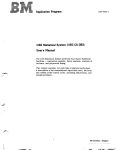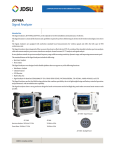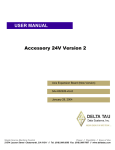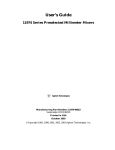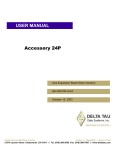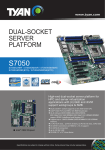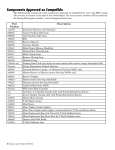Download acc-8d option 9
Transcript
^1 USER MANUAL ^2 Accessory 8D Option 9 ^3 Yaskawa Absolute Encoder Converter Board ^4 3A9-0ACC8D-xUxx ^5 October 27, 2003 Single Source Machine Control Power // Flexibility // Ease of Use 21314 Lassen Street Chatsworth, CA 91311 // Tel. (818) 998-2095 Fax. (818) 998-7807 // www.deltatau.com Copyright Information © 2003 Delta Tau Data Systems, Inc. All rights reserved. This document is furnished for the customers of Delta Tau Data Systems, Inc. Other uses are unauthorized without written permission of Delta Tau Data Systems, Inc. Information contained in this manual may be updated from time-to-time due to product improvements, etc., and may not conform in every respect to former issues. To report errors or inconsistencies, call or email: Delta Tau Data Systems, Inc. Technical Support Phone: (818) 717-5656 Fax: (818) 998-7807 Email: [email protected] Website: http://www.deltatau.com Operating Conditions All Delta Tau Data Systems, Inc. motion controller products, accessories, and amplifiers contain static sensitive components that can be damaged by incorrect handling. When installing or handling Delta Tau Data Systems, Inc. products, avoid contact with highly insulated materials. Only qualified personnel should be allowed to handle this equipment. In the case of industrial applications, we expect our products to be protected from hazardous or conductive materials and/or environments that could cause harm to the controller by damaging components or causing electrical shorts. When our products are used in an industrial environment, install them into an industrial electrical cabinet or industrial PC to protect them from excessive or corrosive moisture, abnormal ambient temperatures, and conductive materials. If Delta Tau Data Systems, Inc. products are directly exposed to hazardous or conductive materials and/or environments, we cannot guarantee their operation. Accessory 8D Option 9 Table of Contents INTRODUCTION ........................................................................................................................................ 1 CONNECTORS............................................................................................................................................ 3 JP1 to JP4 ................................................................................................................................................... 3 JP6.............................................................................................................................................................. 3 JP7.............................................................................................................................................................. 3 JENC1 to JENC4........................................................................................................................................ 3 JP8.............................................................................................................................................................. 3 ADDRESS MAP ........................................................................................................................................... 5 Default Settings.......................................................................................................................................... 5 ABSOLUTE ENCODER SETUP................................................................................................................ 7 PMAC I-VARIABLE SETUP ..................................................................................................................... 9 Ix10 - Motor x Power-On Servo Position Address .................................................................................... 9 I8x - Motor x Resolver Gear Ratio........................................................................................................... 10 I9x - Motor x Second -Resolver Gear Ratio............................................................................................. 10 Ix81 - Motor x Absolute Phasing Position Address ................................................................................. 10 TURBO PMAC I-VARIABLE SETUP .................................................................................................... 11 Ixx10 – Motor xx Power-On Position Address ........................................................................................ 11 Ixx95 - Motor xx Power-On Servo Position Format ................................................................................ 11 Ixx98 - Motor xx Resolver 3rd Gear Ratio (Yaskawa Only) for Turbo .................................................... 11 Ixx99 - Motor xx 2nd Resolver Gear Ratio (Yaskawa Encoder only) for Turbo ...................................... 12 Example: Turbo PMAC Yaskawa Absolute Encoder Setup ................................................................. 12 Turbo PMAC Power On Phasing ............................................................................................................. 12 Ixx81 .................................................................................................................................................... 13 Ixx91 .................................................................................................................................................... 13 Ixx75 .................................................................................................................................................... 14 Ixx80 .................................................................................................................................................... 14 JUMPER SETUP ....................................................................................................................................... 15 CONNECTOR PINOUTS ......................................................................................................................... 17 Headers..................................................................................................................................................... 17 JP1 to JP4 (20-Pin Header) ................................................................................................................ 17 JP6 and JP7 (26-Pin Header) ............................................................................................................. 18 JENC1 to JENC4 (10-Pin Header)...................................................................................................... 18 SERVOPACK 1CN TERMINAL DESCRIPTION................................................................................. 19 TEST SETUP.............................................................................................................................................. 21 YASKAWA ABSOLUTE ENCODER INTERFACE ............................................................................. 23 Jumper Settings ........................................................................................................................................ 23 Jumper E8 & E9 Setup ........................................................................................................................ 23 PMAC I-Variable Setup ........................................................................................................................... 23 Ix10 - Power-On Initial Position Type and Address: .......................................................................... 23 I8x and I9x:.......................................................................................................................................... 24 Ix81 - Motor x Absolute Phasing Address:.......................................................................................... 24 MI11x (Bit 16-23 only-first two digits) ................................................................................................ 24 TROUBLE SHOOTING............................................................................................................................ 25 Data Acquisition Sequence ...................................................................................................................... 25 Checking Up Steps................................................................................................................................... 25 APPENDIX ................................................................................................................................................. 27 Setup Method for 12-bit Absolute Encoder.............................................................................................. 27 Table of Contents i Accessory 8D Option 9 ii Table of Contents Accessory 8D Option 9 INTRODUCTION PMAC’s Accessory 8D Option 9 (P/N 309-0ACC8D-OPT9) allows a PMAC interface to the YASKAWA absolute encoder. This board provides up to 4 channels of absolute encoder inputs to the PMAC controller with both A/B quadrature incremental encoder signal feedback as well as absolute position data. To prevent data from being lost in the case of power loss or power off conditions, a 3V battery is included on the board with a monitor circuit to provide an indication of any drop in excess of 5%. In addition, there are four jumpers on the board to allow the customer to reset the absolute position value. See the related paragraphs below for a detailed description of the absolute encoder setup. The encoder has internal counters and memory that count and retain the incremental counts. Upon power up, it sends RS232 data to PMAC representing the absolute position. Operation is then automatically switched to incremental. Refer to the YASKAWA manual for further explanation. Note If you are using a PMAC with Flash Memory (40 MHz or 60 MHz), you must use firmware version 1.16A or newer. Call the factory for details on upgrading your firmware. Introduction 1 Accessory 8D Option 9 2 Introduction Accessory 8D Option 9 CONNECTORS JP1 to JP4 These connectors are 20-pin Honda connectors that come directly from the absolute encoder. For detail signal description, refer to the YASKAWA manual. JP6 This is a 26-pin header that provides the link between PMAC’s JTHW (J3) and the absolute encoder conversion board through the supplied flat cable. Through this connector, PMAC captures the absolute position. JP7 This is a 26-pin header, which brings out the JTHW signals for the next accessory board on the JTHW multiplex memory map. This connector is pin-to-pin compatible with JP6. JENC1 to JENC4 These are 10-pin headers that provide the normal differential A quad B encoder signal as well as a C channel generated by the absolute encoder. The four connectors are for the first to the fourth encoder, respectively. JP8 This is a 2-pin terminal block for the power supply input. The power requirement of the system is +5V DC @ 10W. External power is needed only when JP6 or JP7 and JENC1-JENC4 are not connected. Connectors 3 Accessory 8D Option 9 4 Connectors Accessory 8D Option 9 ADDRESS MAP ACC-8D Option 9 generates both absolute and incremental position data from the absolute encoder. Normally the absolute position is read (by PMAC) through the Thumbwheel Port (JTHW) only during power up. The incremental (A QUAD B) data, however, is counted continuously. A 5-bit DIP switch, S1, determines the address of this board. The factory default setup is as follows: Multiplex Address Encoder (starting address) 1 2 3 4 5 . . . 27 28 29 30 31 ($08) ($10) ($18) ($20) ($28) . . . ($D8) ($E0) ($E8) ($F0) ($F8) 5 CLOSE CLOSE CLOSE CLOSE CLOSE . . . OPEN OPEN OPEN OPEN OPEN 4 CLOSE CLOSE CLOSE CLOSE CLOSE . . . OPEN OPEN OPEN OPEN OPEN 3 S1 DIP Switch Setting 2 1 CLOSE CLOSE CLOSE OPEN OPEN . . . CLOSE OPEN OPEN OPEN OPEN CLOSE OPEN OPEN CLOSE CLOSE . . . OPEN CLOSE CLOSE OPEN OPEN OPEN CLOSE OPEN CLOSE OPEN . . . OPEN CLOSE OPEN CLOSE OPEN Default Settings 5 4 3 2 1 ON ON ON ON OFF There will be 32 different address settings for a possibility of 32 board connections. Position Set Address Map 5 Accessory 8D Option 9 6 Address Map Accessory 8D Option 9 ABSOLUTE ENCODER SETUP If the battery is connected, the YASKAWA absolute encoder provides 5 digits of signed absolute position data. However, when the absolute position data needs to be cleared to 0, the following setup is needed. 1. 2. 3. 4. Turn off power supply for the entire motor and encoder. Remove the battery from this board. Discharge the capacitor inside of the encoder by moving the corresponding jumper (E1 to E4 for encoder 1 to 4, respectively) from the default setting 2-3 to 1-2, for at least 2 minutes. Place the Jumper back to the default position, and reinstall the battery on the board. This completes the setup. Note The reset procedure may be different for different models of the encoders. Reference the encoder manual for details. Absolute Encoder Setup 7 Accessory 8D Option 9 8 Absolute Encoder Setup Accessory 8D Option 9 PMAC I-VARIABLE SETUP The following PMAC I-variable setup is needed for the system to use the YASKAWA absolute encoder and the ACC 8D Option 9 conversion board: Ix10 - Motor x Power-On Servo Position Address Modes Hex($) Bin 0 1 Address 7 1 1 1 0 0 0 0 1 0 0 0 0 0 0 0 0 0 0 0 0 8 0 0 1 0 0 0 =00-07: Address is multiplexer port address; specifies device # at this port address (resolver) =08-30(hex): Address is PMAC memory I/O address; specifies # of bits (parallel input) =31 (hex): Address is PMAC memory I/O address; data in high 16 bits (e.g. ADC) or Address is multiplexer, data is Yaskawa rev. coun =0: Data at Y address (08-30); ADC data (31) =1: Data at X address(08-30); Yaskawa data (31) =0: Treat as unsigned value =1: Treat as signed value The Ix10 variable will allow the system to enable the absolute encoder and get the absolute position data upon power-on condition. (See PMAC User’s Manual Addendum 1.15 from June 1994.) To define the Ix10 variable correctly, place a $7100 value in front of the beginning address +2 hex for each encoder. Encoder # I-Variable I-Variable Value 1 2 3 4 I110 I210 I310 I410 $710008 $71000A $71000C $71000E An easy way to understand the addressing scheme is to look at the dip switch setting table and place a 1 where the open is located and a 0 for the close position. Now, place three zeros after the switch setting, and convert this binary representation to a hex value. Example: Address 5 4 3 2 1 ($08) ($10) ($18) 0 0 0 0 0 0 0 0 0 0 1 1 1 0 1 000 000 000 The starting address for board #2 (encoders 5,6,7 and 8) would be $10. Therefore, our definitions for the Ix10 variables would be: Encoder # I-Variable I-Variable Value 5 6 7 8 I510 I610 I710 I810 $710010 $710012 $710014 $710016 PMAC I- Variable Setup 9 Accessory 8D Option 9 I8x - Motor x Resolver Gear Ratio I9x - Motor x Second -Resolver Gear Ratio Set I8x= (counts/rev)/4096 I9x= The remainder from above division Example: The number of lines per revolution of the YASKAWA absolute encoder in the system is 8192. PMAC will multiply this term by 4 and read (8192×4) = 32768 counts/rev. ∴ I8x = 32768 =8 4096 I9x = 0 I8x = 8 I9x = 0 Note The I8x and I9x are defined for something else in the PMAC manual for a general-purpose application. It is necessary to use the above definition for this application. Ix81 - Motor x Absolute Phasing Position Address I-Variable Name I-Variable Value Encoder 1 I181 $4(D)C001 * Encoder 2 I281 $4(D)C009 * Encoder 3 I381 $4(D)C011 * Encoder 4 I481 $4(D)C019 * *The number in the parenthesis should reflect the number of lines of the absolute encoder in hexadecimal. To derive this value: 1. Convert the number of lines to a binary number, such as 8192 = 213 = 10000000000000 2. Convert the exponential part (which is 13 in the above example) to a hexadecimal number: 13 (dec.) = D (hex.) Example: If encoder 1 in the system is a YASKAWA absolute encoder with 8192 lines/rev, the correct value for I-181 will be: I-181 = $4DC001 However, encoder 2 in the system is a 12-bit YASKAWA absolute encoder. For instance, if the number of lines/rev for this encoder were 4096, then the right value for I-281 would be: I-281 = $4CC009 Note The last four digits are motor x phasing position address (see PMAC manual on Ix83 for details). 10 PMAC I- Variable Setup Accessory 8D Option 9 TURBO PMAC I-VARIABLE SETUP Ixx10 – Motor xx Power-On Position Address Ixx10 should be set to the multiplexer port location associated with the switch setting of the ACC-8D option9. The following table shows the possible address settings of Ixx10. Board Mux. Addr. Ixx10 Board Mux. Addr. Ixx10 Board Mux. Addr. Ixx10 Board Mux. Addr. Ixx10 0 8 16 24 32 40 48 56 $000100 $000008 $000010 $000018 $000020 $000028 $000030 $000038 64 72 80 88 96 104 112 120 $000040 $000048 $000050 $000058 $000060 $000068 $000070 $000078 128 136 144 152 160 168 176 184 $000080 $000088 $000090 $000098 $0000A0 $0000A8 $0000B0 $0000B8 192 200 208 216 224 232 240 248 $0000C0 $0000C8 $0000D0 $0000D8 $0000E0 $0000E8 $0000F0 $0000F8 Since each ACC-8D option 9 card can support up to four Yaskawa Absolute encoders, the following table list the channel address of each channel relative to the base address. You can see that each successive channel is two addresses (+2) from the previous channel. For simplicity, we have listed the first six board addresses. Board Mux. Addr. Channel 1 Ixx10 Channel 2 Ixx10 Channel 3 Ixx10 Channel 4 Ixx10 $0 $08 $10 $18 $20 $28 $100 $08 $10 $18 $20 $28 $02 $0A $12 $1A $22 $2A $04 $0C $14 $1C $24 $2C $06 $0E $16 $1E $26 $2E Ixx95 - Motor xx Power-On Servo Position Format Ixx95 will be set to a value which tells the controller that the register from Ixx10 will be processed as an ACC-57E absolute encoder. The following table shows the possible settings of Ixx95. Encoder Type Yaskawa Controller Turbo PMAC or Turbo PMAC2 Ixx95 Value $710000 – unsigned $F10000 – signed Ixx98 - Motor xx Resolver 3rd Gear Ratio (Yaskawa Only) for Turbo Ixx98 tells the PMAC how many counts per revolution the Yaskawa Encoder has. The units for this parameter are in counts per revolution divided by 4096. The counts per revolution are based on the decode value of I7mn0. Almost all users will use 4× decode. If the Yaskawa absolute encoder you are using has 32768 counts per revolution, then the user will set Ixx10 to the following value: Ixx98 = 32768 =8 4096 Turbo PMAC I- Variable Setup 11 Accessory 8D Option 9 Ixx99 - Motor xx 2nd Resolver Gear Ratio (Yaskawa Encoder only) for Turbo This is used to let the PMAC know what the remainder from the Ixx98 division is. For most Yaskawa encoders this value will be zero because the majority of their encoders are based on a power of two line count (1024, 2048, 4096, etc.). Example: The number of lines per revolution of the YASKAWA absolute encoder in the system is 8192. PMAC will multiply this term by 4 and read (8192×4) = 32768 counts/rev. ∴ Ixx98 = 32768 =8 4096 Ixx99 = 0 Example: Turbo PMAC Yaskawa Absolute Encoder Setup For this example, we will have the ACC-8D option 9 addressed to the base address $08 based on the SW1 settings. The four encoders for this example have 8192 lines per revolution or 32768 encoder counts (with 4× decode). We will also assume that we are setting up motors 1, 2, 3, and 4. To properly setup the ACC-8D option 9 to read Yaskawa absolute encoders, do the following: Ixx10 Setup I110=$08 I210=$0A I310=$0C I410=$0E ; ; ; ; 1st 2nd 3rd 4th channel channel channel channel ACC-57E ACC-57E ACC-57E ACC-57E Ixx95 Setup I195=$F10000 I295=$F10000 I395=$F10000 I495=$F10000 ;Yaskawa ;Yaskawa ;Yaskawa ;Yaskawa absolute absolute absolute absolute power power power power on on on on position position position position setting setting setting setting Ixx98 Setup I198=8 I298=8 I398=8 I498=8 ; ; ; ; Ixx98 Ixx98 Ixx98 Ixx98 = = = = 32768/4096 32768/4096 32768/4096 32768/4096 ; ; ; ; Ixx99 Ixx99 Ixx99 Ixx99 = = = = remainder remainder remainder remainder = = = = 8 8 8 8 Ixx99 Setup I199=0 I299=0 I399=0 I499=0 from from from from Ix98 Ix98 Ix98 Ix98 calculation calculation calculation calculation Turbo PMAC Power On Phasing All brushless motors require some type of a phase-search on power up to establish a relationship between the zero position of the motor’s commutation cycle and the zero position of the feedback device. Since the data from the ACC-8D option 9 is absolute, the motor phase position relative encoder position is fixed and a “no-movement” motor phase can be performed. To properly phase the motor using the absolute data from the ACC-8D option 9, setup I-variables Ixx81, Ixx91 (for Turbo only), Ixx75, and Ixx80. 12 Turbo PMAC I- Variable Setup Accessory 8D Option 9 The no-movement power-on phase reference works as follows. Initially, when setting up the system (this may be done in a lab setting) the motor is forced to the zero position in its phase cycle. The position of the absolute sensor is read by querying an M-variable previously set up to point to the sensor. After performing some math on this value, the resulting value is stored in PMAC as Ix75 and represents the "power-on phase position offset". Ix81 is set to tell PMAC the address location where it can find the absolute sensor's feedback, and how to decode this information. On power-up (or when a reset motor, "$", command is issued) PMAC will look to this address, grab the current position of the rotor, add to it the pre-determined offset parameter, and instantly it knows where the motor is in its phasing cycle relevant to the current position! No movement is necessary. Ixx81 Ixx81 tells Turbo PMAC what address to read for absolute power-on phase-position information for Motor xx, if such information is present. This can be a different address from that of the ongoing phase position information, which is specified by Ixx83, but it must have the same resolution and direction sense. Ixx81 is set to zero if no special power-on phase position reading is desired, as is the case for an incremental encoder. The ACC-8D Option 9 Yaskawa Absolute Encoder converter board synthesizes quadrature signals into the Turbo PMAC at power-on until the power-on position within one revolution is reached, so the value of the encoder counter can simply be read. Turbo PMAC(1) Ixx81 Encoder Register Settings (Ixx91=$480000 - $580000) Encoder Register Channel # PMAC 1st ACC24P/V 2nd ACC24P/V 3rd ACC24P/V 4th ACC24P/V Channel 1 Channel 3 Channel 5 Channel 7 $078001 $078009 $078101 $078109 $078201 $078209 $078301 $078309 $079201 $079209 $079301 $079309 $07A201 $07A209 $07A301 $07A309 $07B201 $07B209 $07B301 $07B309 Turbo PMAC2 Ixx81 Typical Encoder Register Settings (Ix91=$480000 - $580000) Encoder Register Channel # PMAC2 1st ACC24x2 2nd ACC24x2 3rd ACC24x2 4th ACC24x2 Channel 1 Channel 2 Channel 3 Channel 4 Channel 5 Channel 6 Channel 7 Channel 8 $078001 $078009 $078011 $078019 $078101 $078109 $078111 $078119 $078201 $078209 $078211 $078219 $078301 $078309 $078311 $078319 $079201 $079209 $079211 $079219 $079301 $079309 $079311 $079319 $07A201 $07A209 $07A211 $07A219 $07A301 $07A309 $07A311 $07A319 $07B201 $07B209 $07B211 $07B219 $07B301 $07B309 $07B311 $07B319 Ixx91 Ixx91 tells how the data at the address specified by Ixx81 is to be interpreted. It also determines whether the location specified by Ixx81 is a multiplexer (“thumbwheel”) port address, an address in Turbo PMAC’s own memory and I/O space, or a MACRO node number. For the ACC-8D option Ixx91 will be set to a value of $580000. Turbo PMAC I- Variable Setup 13 Accessory 8D Option 9 Ixx75 Ixx75 tells Turbo PMAC the distance between the zero position of an absolute sensor used for power-on phase position (specified by Ixx81 and Ixx91) and the zero position of Turbo PMAC's commutation cycle. It is used to reference the phasing algorithm for a PMAC-commutated motor with an absolute sensor (Ixx81 > 0). Please see Software Reference for proper setting. Ixx80 Ixx80 controls the power-up mode, including the phasing search method (if used), for Motor xx. If Ixx80 bit 0 is 1 (Ixx80 = 1 or 3), this is done automatically during the power-up/ reset cycle and it also be done in response to a $ on-line command to the motor, or a $$ on-line command to the coordinate system containing the motor. If Ixx80 is set to 0, phasing will also be done in response to a $ on-line command to the motor, or a $$ on-line command to the coordinate system containing the motor. 14 Turbo PMAC I- Variable Setup Accessory 8D Option 9 JUMPER SETUP Jumper Position Description Default Setting Encoder 1 absolute data reset E1 2-3 Encoder 1 normal operation Default Encoder 2 absolute data reset E2 2-3 Encoder 2 normal operation Default Encoder 3 absolute data reset E3 2-3 Encoder 3 normal operation Default Encoder 4 absolute data reset E4 2-3 Encoder 4 normal operation Default E5 E6 Additional driver for LED CPU reset out 2-3 CPU normal operation Default E7 Bootstrap mode Default Jumper Setup Single chip 2-3 15 Accessory 8D Option 9 16 Jumper Setup Accessory 8D Option 9 CONNECTOR PINOUTS Headers JP1 to JP4 (20-Pin Header) Top View Pin # Symbol Function Description 1 GND Common Encoder Common 2 GND Common Encoder Common 3 GND Common Encoder Common 4 SEN Power +5V 5 SEN Power +5V 6 SEN Power +5V 7 NC 8 NC 9 NC 10 RESET Input Encoder Reset 11 NC 12 BAT + Input +3V 13 BAT Input Encoder Common 14 PHASE C Output Channel C+ 15 *PHASE C Output Channel C16 PHASE A Output Channel A+ 17 *PHASE A Output Channel A18 PHASE B Output Channel B+ 19 *PHASE B Output Channel B20 F-GND Common Encoder from Ground 1. Channel C/ is terminated at the connector. The part number and manufacture information for connector JP1-JP4 is as follow: Manufacture: HONDA Part number: MR-20RMD2(male) Mate-in connector part number: MR-20F (Vendor: CONNEX - Fremont, CA Telephone: 1-800-972-5932) Connector Pinouts Notes 1 17 Accessory 8D Option 9 JP6 and JP7 (26-Pin Header) Top View Pin # Symbol Function 1 2 3 4 5 6 7 8 9 10 11 12 13 14 15 16 17 18 19 20 21 22 23 24 25 26 GND GND DAT0 SEL0 DAT1 SEL 1 DAT2 SEL2 DAT3 SEL3 DAT4 SEL 4 DAT5 SEL5 DAT6 SEL6 DAT7 SEL7 N.C. GND N.C. GND N.C. GND +5V N.C. Common Common Output Input Output Input Output Input Output Input Output Input Output Input Output Input Output Input PMAC Common PMAC Common Data Bit 0 Address Line 0 Data Bit 1 Address Line 1 Data Bit 2 Address Line 2 Data Bit 3 Address Line 3 Data Bit 4 Address Line 4 Data Bit 5 Address Line 5 Data Bit 5 Address Line 6 Data Bit 6 Data Bit 7 Description Common PMAC Common Common PMAC Common Common Input PMAC Common +5V DC Supply Notes Not connected Not connected Not connected Not connected JENC1 to JENC4 (10-Pin Header) Top View 18 Pin # Symbol Function 1 2 3 4 5 6 7 8 9 10 CHA1 +5V GND CHA1/ CHB1/ GND +5V CHB1 +5V CHC1 Output Input Common Output Output Common Input Output Input Output Description A Channel Power Supply Digital Ground Neg. A Channel Neg. B Channel Digital Ground Power Supply B Channel Power Supply C Channel Notes H.P. Standard H.P. Standard H.P. Standard H.P. Standard H.P. Standard H.P. Standard H.P. Standard H.P. Standard H.P. Standard H.P. Standard Connector Pinouts Accessory 8D Option 9 Servopack 1CN Terminal Description (For Σ Series Motor and Absolute Encoder) Terminal Label 1 SG 2 SG 3 PL1 4 SEN 5 V-REF 6 SG 7 PULS 8 *PULS 9 T-REF 10 SG 11 SIGN 12 *SIG 13 PL2 14 *CLR 15 CLR 16 TQR-M 17 VTG-M 18 PL3 19 PCO 20 *PCO 21 BAT 22 BAT0 23 +12V 24 -12V 25 V-CMP(COIN+) 26 V-CMP(COIN-) 27 TGON+ 28 TGON29 S-RDY+ 30 S-RDY31 ALM+ 32 ALM33 PAO 34 *PAO 35 PBO 36 *PBO 37 ALO1 38 ALO2 39 ALO3 40 S-ON 41 P-CON 42 P-OT 43 N-OT 44 ALM-RST 45 P-CL 46 N-CL 47 +24V IN 48 PSO 49 *PSO 50 FG Connector Pinouts Description 0V 0V Power supply for open collector reference SEN signal input Speed reference input 0V Reference pulse input Reference pulse input Torque reference input 0V Reference sign input Reference sign input Power Supply for open collector reference Error counter clear input Error counter clear input Torque monitor Speed monitor Power supply for open collector reference PG dividing output phase C PG dividing output phase C Battery (+) Battery (-) Power supply for speed/torque reference Power supply for speed/torque reference Speed coincidence signal output Speed coincidence signal output TGON output signal TGON output signal Servo ready output Servo ready output Servo alarm output Servo alarm output PG dividing output phase A PG dividing output phase A PG dividing output phase B PG dividing output phase B Alarm code output (open collector output) Alarm code output (open collector output) Alarm code output (open collector output) Servo ON input P control input Forward over-travel input Reverse over-trivial input Alarm reset input Forward external torque limit ON input Reverse external torque limit ON input External power supply input Phase S signal output Phase S Signal output Frame ground 19 Accessory 8D Option 9 20 Connector Pinouts Accessory 8D Option 9 TEST SETUP The diagram below shows how to connect the ACC-8D Option 9 accessory board to PMAC. For this example, we will be using a Yaskawa UTMAH-B15AS absolute encoder mounted on the back of a USAGED-2AS2K AC Servo Motor. The encoder has 8192 counts/rev. As shown in the diagram, we will be connecting the encoder to PMAC’s encoder channel #1. Once everything is properly connected, power up the system. Next, go into the Executive program and open the position window. If you spin the motor by hand, you should see the position of motor #1 moving. Test Setup 21 Accessory 8D Option 9 Special cable p/n: 3C9-OACC8D-OPT 22 Test Setup Accessory 8D Option 9 YASKAWA ABSOLUTE ENCODER INTERFACE (MACRO Interface Version) Jumper Settings Jumper E9 selects the compact MACRO interface RS232 (or thumbwheel communication) function. The jumper position is read once at power up, so any changes made after that are invalid. Once the MACRO interface function is active, the communication between the interface card and the MACRO station is established via RS232. A RS232 cable must be plugged into P2 on the interface card (see the wiring diagram for details). Two ACC-8D Option 9 cards are allowed in one system. The card address is defined by jumper E8, and is read at power up. Changes to the setting of jumper E8 will not be read until the next time power is turned on. Jumper E8 & E9 Setup Jumper E8 Position Description Default Setting In Out In * Out Interface board address bit board # 1-for encoder 1 to 4 Jumper in Interface board address bit board # 2-for encoder 5 to 8 E9 Thumbwheel port communication version Jumper in RS232 communication version (compact MACRO station only) * For compact MACRO interface application, and for firmware version 1.106 and later, the thumbwheel communication is supported. PMAC I-Variable Setup The following PMAC I-Variable set up are for MACRO interface version only: Ix10 - Power-On Initial Position Type and Address: # of Encoder I-Variable Name PMAC: I-Variable Value 1 I110 $72(0000) 2 I210 $72(0001) 3 I310 $72(0004) 4 I410 $72(0005) 5 I510 $72(0008) 6 I610 $72(0009) 7 I710 $72(000C) 8 I810 $72(000D) The numbers in parenthesis are valid MACRO motor nodes. The motors are assigned to a Y-MACRO motor node. Yaskawa Absolute Encoder Interface 23 Accessory 8D Option 9 I8x and I9x: I8x=(counts/rev.)*/4096 I9x= the remainder from above division Note Here the counts/rev. = Encoder lines/revolution X 4. Ix81 - Motor x Absolute Phasing Address: The following table is a function of its motor X and its MACRO motor node N: # of Encoder I-Variable name PMAC I-Variable Value PMAC2 I-Variable Value Y-MACRO Motor Node N 1 I181 $(12)C223* $(12)C0A3* 0 2 I281 $(12)C227* $(12)C0A7* 1 3 I381 $(12)C22B* $(12)C0AB* 4 4 I481 $(12)C22F* $(12)C0AF* 5 5 I581 $(12)C233* $(12)C0B3* 8 6 I681 $(12)C237* $(12)C0B7* 9 7 I781 $(12)C23B* $(12)C0BB* 12 8 I881 $(12)C23F* $(12)C0BF* 13 The number in the parenthesis should reflect the number of lines of the absolute encoder in HEX. To derive this value: 1. 2. 3. Convert the number of lines to a binary number, such as 8192 = 2 Add 5 to the exponential part (which is 10 in the above example). That is: 13 + 5 =18 Convert the result to hex representation: 18(dec) = 12 (hex) 13 MI11x (Bit 16-23 only-first two digits) The following are MACRO I-Variables: I11n Bits 16-23 Type of Feedback $71 Yaskawa Absolute Encoder Converter through Multiplexer Port (bits 0-15 equal to Thumbwheel address) $72 Notes Used for ACC-8D Opt 9 connected to CPU board JTHW port (use E9 to configure); address is multiplexer port address ($00 $FF) Used for ACC-8D Opt 9 connected to CPU board serial port. Yaskawa Absolute Encoder Converter through RS-232 interface (bits 0-15 equals 0). Reference “MACRO Station Software Reference” manual for details. 24 Yaskawa Absolute Encoder Interface Accessory 8D Option 9 TROUBLE SHOOTING Data Acquisition Sequence The ACC-8D Option 9 Yaskawa interface card is a slave card for PMAC. It acquires the absolute data only when PMAC requests it. The absolute position data is obtained by sending out ‘SEN’ signal (+5V) to the encoder. The power will remain on if the data is successfully acquired. It will turn off (0V) if the data is not received within approximately 1.5 seconds. Checking Up Steps If there is no position data showing on the PMAC window, the following steps could be followed to check the card: Step 1: Is the jumper setting right? Which includes: • Dip switch S1. • E-point jumpers E1-E9 Step 2: Is there power applied to the card? Refer to page 2 of this manual for JP8. Check with meter on ‘TP11’ and ‘TP12’ to verify (should be 5V). Step 3: Compare all the necessary PMAC I-variables with this manual: PMAC is shipped with all the I-variables in default values. The ACC-8D Option 9 user has to change the related I-variable according to this manual. A “save” command has to be executed in order to keep those values from being lost when the ‘$$$’ command or a power recycle occurs. Step 4: Does the encoder need to be reset? Reference your YASKAWA motor and encoder manual for detailed information on how to reset the absolute position data. If some encoders are disconnected from the battery (on this card) for a certain period of time, either the absolute position data will be lost, (back to 0) or a reset procedure will need to be done before the encoder starts working correctly. Troubleshooting 25 Accessory 8D Option 9 26 Troubleshooting Accessory 8D Option 9 APPENDIX Setup Method for 12-bit Absolute Encoder To clear the cumulative rotation number to zero for testing the motor, or when the absolute encoder has been left disconnected from a battery for more than two days, the encoder needs to be setup by the following procedure. (Under the above conditions, capacitors in the encoder may be charged insufficiently so that the internal circuits may malfunction.) Strictly follow the procedure. Otherwise, an error may occur. 1 Turn ON power to the SGD SERVOPACK. Connect the SGD SERVOPACK, motor, and encoder properly. Connect the battery and turn ON power to the SGD SERVOPACK. 2 Set the SEN signal (1CN-4) high. When the SEN signal is high, +5V power is supplied to the encoder. Keep this condition for three minutes or longer to fully charge the backup capacitor. 3 Data reset Turn OFF power to the SGD SERVOPACK. Remove the encoder connector. Connect connector terminal 13 and 14 of the encoder for one or two seconds. 4 Wiring Restore the normal wiring. 5 Power ON Turn ON power tot he SGD SERVOPACK. Set the SEN signal to high-level. If no error occurs, setup has been completed. If alarm is 0. output, restart from step 1. Appendix 27 Accessory 8D Option 9 28 Appendix Accessory 8D Option 9 Appendix 29




































